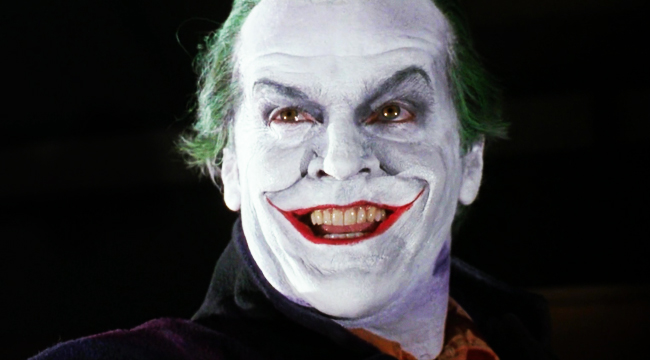
It’s clear when re-watching Batman ’89 for its 30th anniversary that it lacks the dimension (and scope) of a modern comic book movie, but there is something to be said for its simplicity. Especially in 2019.
Sam Hamm and Warren Skaaren’s script for Tim Burton’s film doesn’t drill down deep into the psychology of either Jack Nicholson’s Joker or Michael Keaton’s Bruce Wayne/Batman. They are who they are, secure in their actions and shaped by their linked personal histories. But those histories are only lightly explored, with only the weight of relevance assigned to Bruce Wayne’s traumatic youth. No one really cares why The Joker is the way he is, certainly not Burton.
Contrast that with the film’s immediate sequel, Batman Returns, where we’re fed more complex origins for Michelle Pfeiffer’s Catwoman and Danny DeVito’s Penguin. It’s to such an extent that we’re made to feel bad for these lost souls who never feel like pure, irredeemable villains. Not in the way that Nicholson’s Joker did, at least. Now, contrast that with Batman Forever and Jim Carrey’s Riddler and Tommy Lee Jones’ Two-Face. With Burton gone from the director’s chair, Joel Schumacher took over the franchise for the third film and went back in the other direction. He rejected the idea that we should feel for The Riddler and Two-Face and, instead, banked on volume and color to synthesize what Burton got from Nicholson. The result is a loud but pointless neon explosion. It’s a poor imitation, lacking in palpable danger, menace, and most importantly, the inventiveness, quirk, and legitimate zeal that made Nicholson’s portrayal legendary. I don’t even blame Schumacher for trying. Everyone else has with every other villain in every other comic book movie. All with varying degrees of failure, despite how much better and/or layered the story is.
The people of Gotham aren’t fleshed out in Batman ’89, either. That’s not a complaint, but it’s interesting to see how subsequent movies have treated the citizens upon whom hero-ing and super-villainy are inflicted. Often, these films fall in line with the trope where rubble covered citizens crane their necks up, watch the sky as their cities get tossed about by warring Gods and alien forces, and do… well, nothing. Or sometimes they grouse about it, but mostly, these well-meaning, 9-5 ants exist to inspire amazing acts of self-sacrifice (and then acts of introspection) with their sheer existence. Batman ’89, on the other hand, treats its Non Playable Characters with a measure of disdain. The people of Gotham are vain and money-hungry. Despite the fact that The Joker giddily poisons their health and beauty products, they don’t run away when he offers to throw a massive party. Instead, they flood the streets, hands outstretched looking for their piece of the $20 million dollars he has promised to giveaway.
Burton’s take on the hoi polloi of Gotham is an incredibly cynical look at human nature’s most bent parts. But it feels pretty spot on, doesn’t it? After all, many people did (and still do) clamor for “Make America Great Again” promises emanating from a man who poisoned (or, poisons) the country with Birtherism and other fear-baiting tactics. Mash up parts of The Joker’s appeal to the people of Gotham and Oswald Cobblepott’s candidacy for Mayor in Batman Returns, and Burton’s Batman films become one hell of a meditation on politics… more than a quarter century ahead of their time.
Christopher Nolan’s Dark Knight (another Batman film anchored by a tremendous but very different Joker portrayal) and The Dark Knight Rises also dares to tell a story that doesn’t let society off the hook. This while focusing on chaos, anarchy, heroes, villains, and the power of fear. But while there’s no doubt that Nolan’s films feel more gritty and real when compared to the world around us, re-watching them now doesn’t connect with me as much as Batman ’89 does in these times where the mainstream media’s fetishistic need to explore the psychology behind every ill deed and evildoer runs rampant.
While I’d never trade the higher art of some of the more recent comic book movies that are free to go deeper and wider (a move that had to happen for these creations to get broad acceptance and earn their continuing existence) or speak more directly to larger issues, I am sure glad something simple like Batman ’89 exists. 30 years on and it still feels like a comfortable, economic, and tidy story where the hero wins, the villain loses, and efforts to shatter the status quo make a mark but do not succeed.
I expect that Joker, Todd Phillips’ upcoming deep dive into The Joker’s pain, will be lauded. Same with Joaquin Phoenix’s portrayal of the title character. And up until recently, I expected that I’d be first in line to see it and eager to cheer a different look at the character. But on second thought, I think I may be joining the chorus of people who are tired of trying to learn more about and understand monsters.
